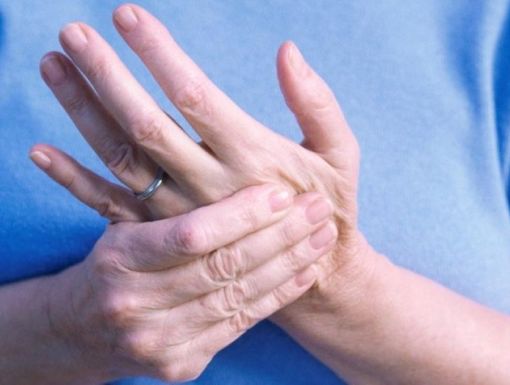
Why Do My Hands Hurt? 5 Reasons for the Pain
We put our hands through a lot each day. From working at our computer, to texting and even getting dressed in the morning. When your hands hurt, it can impact your day-to-day routine and make some activities unpleasant to complete.
The five most common causes of hand pain are:
- Carpal tunnel syndrome
- Trigger finger
- Arthritis
- Gout
- Repetitive strain injury
Learn more about these common reasons for hand pain and how to treat them.
What is carpal tunnel syndrome and what causes it?
Carpal tunnel syndrome is a condition that affects one of the main nerves in the wrist. Caused by the compression of the nerve that runs from the forearm into the palm of the hand, carpal tunnel syndrome often causes numbness or tingling in the thumb, index and middle fingers. The carpal tunnel is a passageway of ligaments and bones at the base of the hand that houses this nerve and the tendons that allow your fingers to bend. When the carpal tunnel becomes irritated, it can compress that nerve.
In most cases of carpal tunnel, the numbness or tingling comes on gradually. In a mild case, symptoms may come and go for months or even years. For others, symptoms can be constant and will usually worsen over time. According to the American Society for Surgery of the Hand, there are risk factors that increase the chances of getting carpal tunnel syndrome. These include obesity, diabetes, alcohol addiction, fibromyalgia and hypothyroidism. Women are more likely than men to experience carpal tunnel and it’s more likely to occur with aging.
Symptoms of carpal tunnel can include:
- Numbness and tingling that is often worse at night
- Fingers feeling swollen
- Dropping objects
- Discomfort in wrist, hand or fingers
- Weak or uncomfortable pinch
A carpal tunnel syndrome diagnosis is based on your history of symptoms and a physical exam. It is important to know which fingers experience numbness or tingling and which fingers don’t. Your doctor may perform sensation testing on the palm side and the back side of your fingers and hand. Non-surgical options for treating carpal tunnel include anti-inflammatory medication, steroid injections and the use of a wrist splint. The goal of treating carpal tunnel is to reduce or remove the causes of increased nerve pressure which will result in a decrease in symptoms.
What is trigger finger and how is it treated?
Trigger finger is a common condition that causes pain, stiffness and a feeling of “locking” or “catching” when you bend or straighten your finger. The condition, also known as stenosing tenosynovitis, most often affects the ring finger and thumb, but it can occur in the other fingers. When the thumb is involved, the condition is called “trigger thumb.”
Trigger finger involves the inflammation or irritation of the pulleys and tendons in the hand that allow us to bend our fingers. In most cases, the cause of trigger finger is not known, but can be associated with conditions such as diabetes, gout or repetitive strain or gripping. Symptoms of trigger finger can include pain, swelling and loss of motion. Early on symptoms may be mild, but as the tendon becomes tighter the pain can increase. In a severe case, the affected finger may become locked in a bent position.
Your doctor will be able to diagnose trigger finger by discussing your symptoms and examining your hand. Typically, X-rays or other tests are not needed. The good news is that most treatments don’t involve surgery. Common treatments include:
- Anti-inflammatory medication: Many times, oral or topical anti-inflammatory medication (like ibuprofen or naproxen) can be used to relieve pain and improve the ability to move your finger.
- Steroid injection: Corticosteroid injections, also known as a cortisone shot, can be given at any stage of symptoms or duration. However, experts say these injections are more successful when they are given early.
- Hand therapy: Patients may benefit from physical therapy and home exercises. It can be helpful to have a hand therapist teach concepts and techniques such as joint motion, tendon gliding and other treatments.
How does arthritis affect the hands and what are the treatment options?
Arthritis is the inflammation of the joints that causes pain and stiffness. When the joints are affected by arthritis, daily activities can be difficult. There are more than 100 types of arthritis affecting more than 58 million Americans, according to the Centers for Disease Control. Arthritis can occur in many areas of the hand and wrist and can have more than one cause. Over time, if arthritis is not treated, the bones that make up the joint can lose their normal shape causing additional pain and further limiting your motion. Symptoms of arthritis in the hand include joint pain that may feel “dull” or a “burning” sensation.
Your doctor can diagnose arthritis by examining the hand and taking X-rays. A bone scan may also be used to help diagnose arthritis when it is in an early stage, even if an X-ray looks normal. Treating arthritis in the hands can vary depending on how advanced it is. Non-surgical treatment options include rest, therapy, non-steroidal anti-inflammatory drugs and steroid injections.
What causes gout in the hands and how can it be managed?
Gout can be extremely uncomfortable and painful. Gout occurs when excess uric acid (a normal waste product) collects in the body causing crystals to form in the joints. This can happen because uric acid production increases or, more often, the kidneys cannot remove uric acid from the body. This buildup can lead to red, swollen joints. The joints in your hands can become so painful that they hurt to move. Sometimes, they can even seem like they are infected, even though they aren’t.
A gout attack can start suddenly and can last days or weeks. These flare-ups can be followed by long periods of remission that can last weeks, months, or years. Symptoms of gout can include intense pain, swelling, redness and heat. Several factors can contribute to gout, including:
- Obesity
- Having certain health conditions such as congestive heart failure, hypertension (high blood pressure), diabetes and poor kidney function
- Drinking alcohol in excess
It is also more common in men. Fortunately, it is possible to treat gout and reduce painful attacks by avoiding certain foods and taking medication. The American College of Rheumatology says lifestyle changes such as controlling weight and limiting alcohol can help control gout. However, diagnosing gout can be difficult. It’s important to see your doctor if you are experiencing any of these symptoms.
What is a repetitive strain injury and how can it be prevented?
A repetitive strain injury is damage to your muscles, tendons, nerves or ligaments caused by doing the same motion or activity repeatedly until it starts to hurt your body. These types of injuries are common and typically affect your fingers, thumbs and wrists. For many people, a repetitive strain injury can stem from typing on a computer for long hours, sports activities and even playing video games.
Symptoms can include tenderness, stiffness, tingling and swelling. The best treatment is to reduce the activity that caused your injury to prevent further damage. You can also apply a cold compress to your injury 15 minutes at a time a few times a day. Wrapping your injury in an elastic bandage can help reduce swelling. Over-the-counter medications like or ibuprofen can reduce also help in relieving pain and inflammation.



